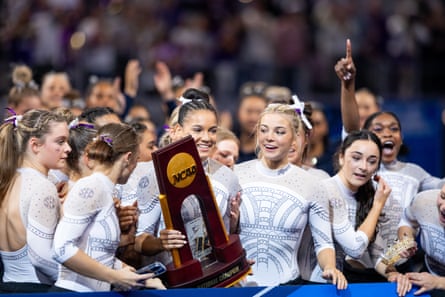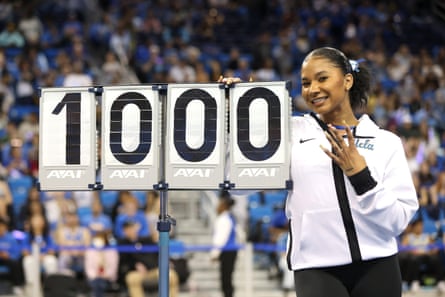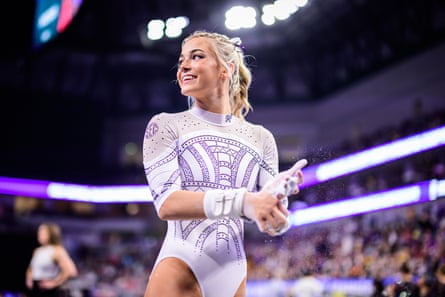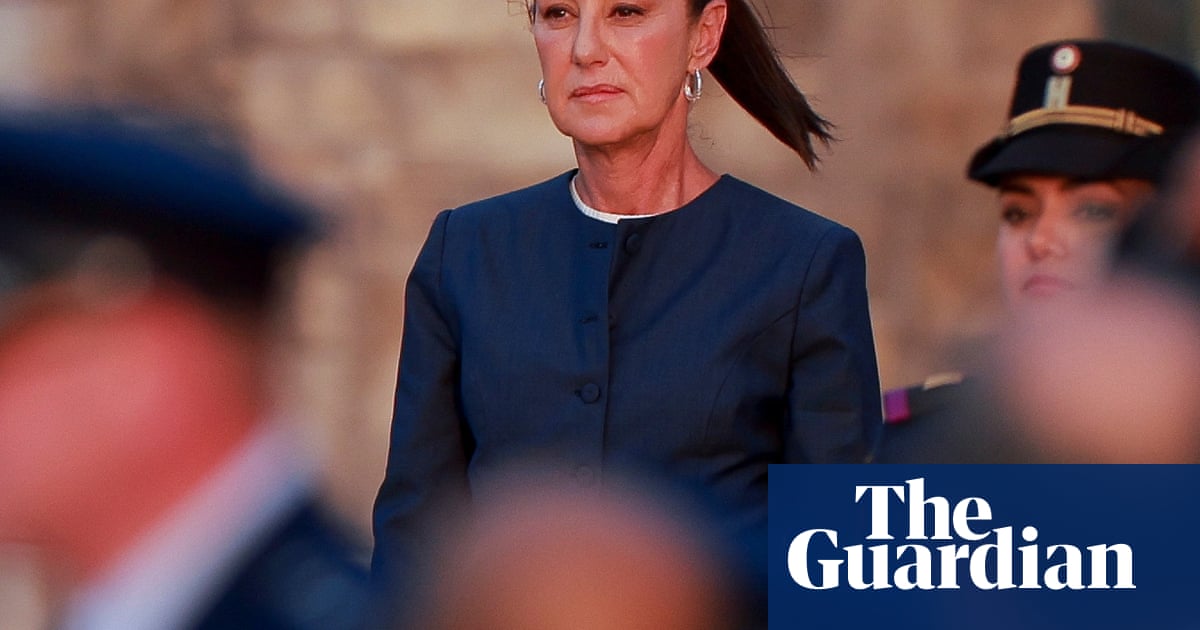Livvy Dunne is worried about the future of women’s college gymnastics. The NIL powerhouse, who has scored major brand deals with Vuori and American Eagle, among others, has started her final season with the national champion LSU Tigers. But she’s made the biggest splash in this young season on social media by posting on X over her concerns over the popularity of gymnastics.
“I’m sitting here watching NCAA gymnastics and the empty seats are concerning,” she wrote in a note on X last week. “If you want fans to enjoy the sport and increase viewership, you have to look at what makes the crowds go crazy! People understand what a perfect 10 is and want people who do things that look great to be rewarded.”
The context behind Dunne’s note on social media are the changes that have been made to judging this season. A new accountability system has just been implemented to deal with the overscoring of seasons past and the proliferation of perfect 10s. Last year, there were 87 perfect marks in women’s college gymnastics, just a few shy of the highwater mark of 91 back in 2004. And behind all of those 10s, were even more 9.975s (meaning at least one judge threw out a 10 for that score), 9.95s and 9.9s. At times, it felt like the judges weren’t rigorously evaluating gymnasts’ routines based on the performance so much as scoring based on vibes, usually good ones, mirroring the enthusiasm of the athletes and crowds with their marks. The acceptable range for a “hit” routine had become quite narrow, a window of about two tenths, so that the judges didn’t have the room to distinguish between the good, the great and the truly sublime.
So far this season, there’s been a notable downturn to the scores. There are still many high marks being handed out but routines that in years past might have earned a 9.9 was getting 9.8s; and there have only been three 10s so far when at this point in 2024, there had been more than 20. If the trend continues, there will be far fewer 10s this season than there have been in many years. (Though it seems like we’re mostly in wait-and-see mode when it comes to the implementation of the new judging system; they’re mostly collecting data and not acting on it this year. Perhaps the threat alone was enough to get judges to become more rigorous.)
There was immediate pushback to Dunne’s note, particularly from gymnastics fans who have watched the creeping scoring inflation of the past five years with increasing concern. Many also pointed out that the viewership and attendance numbers were sound, great even, through the first month of the season, picking up right where they left off last season. Though Dunne didn’t specify which meet she was watching when she posted, it was probably the Missouri-Kentucky showdown on Sunday, which aired opposite the AFC Championship game between the Bills and the Chiefs, which was held about two hours away from the gymnastics competition and drew a historically high TV audience. This goes a long way to explaining its sparser-than-usual crowd. No gymnastics meet, not even one featuring Dunne and the rest of the LSU Tigers, would’ve stood a chance against one of the most important football games of the year that also happened to have Taylor Swift in attendance. The judges could’ve gone full Oprah and given everyone a 10 and it still wouldn’t have changed the attendance and viewership numbers.

“People are like, ‘I don’t understand why she’s complaining because this school is breaking records’… but it’s about keeping those people engaged and wanting more,” Dunne told the Guardian in a phone conversation last week about this particular line of criticism. “My concern is the longevity of gymnastics and keeping fans interested for the long run.”
The backdrop of her note and these remarks is the looming House v NCAA settlement, which will bring revenue sharing to college sports and she, like many others, is concerned about the fate of the non-revenue programs. “Gymnastics is at the point right now where it could be a filled arena of record-breaking attendance, but it’s still a non-revenue sport.” Anything that might potentially cause a dip in popularity and fan engagement, such as the new judging accountability system and resultant lower scores, seems like the wrong choice to Dunne at this particular juncture. “I don’t think that [the] timing is right because of what’s happening in the future.”
The connection between scoring and popularity in gymnastics is hardly straightforward. Yes, Nadia Comăneci’s first Olympic 10s were a huge global sensation, but those were awarded against the backdrop of a mega sporting event and in the midst of the Cold War. And Comăneci wasn’t even the first global superstar in women’s gymnastics. That distinction belongs to Olga Korbut of the Soviet Union who became the darling of Munich four years earlier despite never having received a 10; she won the crowds and the TV viewing audience over with her daring acrobatics and her endearing personality.
In the years following Comăneci’s gold medals, 10s proliferated to the point where it became something of a crisis for the sport. Viewers, who had been repeatedly told that the 10 meant “perfection”, were seeing obviously flawed exercises receive that mark at the 1988 Olympics. These 10s were not a source of excitement but of suspicion. The final perfect marks in gymnastics were awarded in 1992 and by 2006, the International Gymnastics Federation (FIG) eliminated the 10 in favor of the open ended scoring paradigm. The concerns that Dunne cited in her statement – that people understand the 10 and get excited for it – are echoes of the arguments that those opposed to the shift made in the 90s and early aughts. But the popularity of elite gymnastics hasn’t appeared to suffer as a result of the scoring change. It’s been nearly 20 years now and everyone has gotten used to it. And Simone Biles, the GOAT of the sport, has thrived under this open ended scoring system (though she probably would thrive under any scoring regimen).
Women’s college gymnastics has also had an up-and-down relationship with the perfect 10. There certainly have been gymnasts whose perfect marks have helped increase interest in the sport. In 2014, LSU gymnast Lloiminica Hall became the first gymnast to go viral on social media on the strength of her engaging floor routine; the 10 she was awarded probably played a big part in its spread albeit but in a circuitous way. She was awarded the perfect mark at a dual meet in January and the video of the performance lay dormant on YouTube until the spring when a sorority website found it and posted it. From there, it went viral, resulting in articles about Hall and an interview on Good Morning America. It’s reasonable to conclude that the “10” in the video header increased its discoverability. Basically, it was good SEO.
Several floor routines have gone viral since then and not all have been awarded 10s. Sophina DeJesus managed to attract the internet’s attention with her 9.925 routine in 2016 that got her featured in the LA Times and on Ellen. In 2020 and 2021, Nia Dennis’s sub-10.0 routines also led to significant media attention. Katelyn Ohashi, the most viral of them all, was awarded a 10 in 2019, but that came on the heels of DeJesus’s success at UCLA as well as Ohashi’s less celebrated viral moment from 2018. The early example of Hall aside, these later bouts of virality seem to be less about a particular score and more about performance quality, choreography, music selection and schools’ investments in digital marketing and social media. (But all the scores were in the 9.9+ range so it’s not like any of the viral performances were lowballed even if they didn’t receive 10s.)
As the 10s have abounded in college gymnastics, starting in the early 90s, they’ve also attracted a fair share of scrutiny for the same reason they came under fire in elite – though some were earned, many were seen as illegitimate, “imperfect” 10s for flawed performances. Last year, there was coverage of the scoring problems of women’s college gymnastics in the Washington Post and it was amply discussed by commentators in the television broadcasts, at times even joking about the implausibility of some of these marks.

But this certainly doesn’t mean that the 10 has no role to play in increasing the popularity and reach of the sport. Dunne brought up Missouri’s Helen Hu’s 10 from the previous weekend. Hu, a fifth year like Dunne, has been known for her balance beam prowess and elegance since her high school days, but hadn’t yet scored a 10 despite getting very close on several occasions. But in the early season meet, as the last one up for her team, she finally was awarded one for a routine that, in my non-judge estimation, truly deserved the accolade.
“Those great moments do make SportsCenter Top 10,” Dunne observed in regards to Hu’s performance which was highlighted. “That’s what gymnastics needs. It needs eyes on the sport. It needs eyes from the average consumer.”
Would ESPN, when choosing moments to highlight, have landed on Hu’s beam routine if it had been performed identically but had received only a 9.975? Probably not. As with Hall’s viral 2014 moment, the 10 aids in discoverability, not just for fans, but producers of sports programs, too. Hu’s exemplary routine would’ve been much more difficult to pluck out from the sea of 9.95s.
But what of fan – and producer – education? Should we attempt to teach people what to look for in routines instead of relying on high numbers to do the work of spotlighting the exceptional performances?
When it comes to learning about how routines are being evaluated, TV viewers are probably at a distinct advantage compared to the fans watching live inside the competition venue. Since the start of the season, television commentators have repeatedly stressed the introduction of the accountability system to help the lower scores seem more plausible. Inside the arena is a different story. “I think it’s definitely different in the arena because fans aren’t being told anything,” Dunne said. “It’s just based off of the energy and honestly how good the performance is.”
And when there appears to be a mismatch between the crowd’s energy in response to what they perceive as a perfect or near-perfect exercise and the marks that a gymnast receives, confusion ensues. “People I know for a fact are confused,” she said. “The amount of people that have reached out to me, I can’t even wrap my head around.”
She fears that this confusion will lead to fan disengagement, especially for the newer ones who are still quite casual in their commitment to women’s college gymnastics. “I have been on social media since I was 10 and once you lose someone’s attention and they’re not interested anymore, that’s it.”
“I definitely feel like the scoring should be fair. Should be fair across the board,” Dunne said. “But it’s also very confusing for fans when the scoring has been one way for three years.”
What Dunne is getting at is a perennial problem for gymnastics – the relative instability of the rules. With most other sports, there might be a steep learning curve at the beginning, but once you know the rules, you’re set for years to come. But in gymnastics, skill values can change from year to year and so can requirements. Keeping abreast of all these developments doesn’t seem like much of a commitment to a hardcore gymnastics fan but might be a tall order for a more casual viewer who just wants to see some cool stuff.
But there’s a tension between wanting fair scoring and also being responsive to fan enthusiasm that may not be informed by any kind of gymnastics expertise. A casual fan might know that anything 9.9+ is a good score and that a stuck vault is a good vault. But they might not realize, without the benefit of replay, that the vault they leapt to their feet over had myriad form problems in the air that demanded deductions because there is another gymnast out there, perhaps later in the same lineup, who might do both – stay clean in the air while sticking the landing. The only way to reward the gymnast who will execute on both ends is to deduct the one with clear flaws. In that case, the judges have to ignore fan demands and get their pencils out.
While her primary concern was the fans and the coming of revenue sharing, Dunne also spoke about the emotional impact of the scoring on the athletes themselves. A 10 isn’t simply the highest score you can be awarded; for many gymnasts it’s a culminating career moment. “When they did flash it [the 10], I think my knees buckled a little bit. I started crying. I didn’t know what to do with myself,” Hu told Inside Gymnastics of her reaction to this milestone achievement.
“You come to college to have fun and to finally get rewarded after those hard years of club or elite gymnastics, especially in this era of gymnast[s] that did have to go through what they did in Texas,” Dunne said.
She, along with many of the gymnasts currently competing in the NCAA had been on the national team at one point in their careers. And as has been well documented since 2016, many of these athletes have suffered abuse in various forms, from physical to sexual, and almost certainly emotional. The upperclassmen of the NCAA are perhaps the last group of gymnasts to have attended the national team training camps at the Karolyi Ranch in Texas before it was shut down in early 2018 after Biles, who had just come forward as a victim former USA Gymnastics team doctor Larry Nassar, publicly expressed her anguish that continuing her career – she had just embarked on a comeback after taking the year after the 2016 Games off – would mean that she’d have to return to the site of her abuse. Dunne has never spoken publicly about being abused herself though she must know several athletes who have been. For many gymnasts, college gymnastics is the light at the end of a dark tunnel. (Though not for all since we’re still talking about a Division I sport where coaches want to win as much as they do at the elite and club levels and can be abusive too.) The cheers, excitement, and the 10s are part of the happy ending that many of the athletes who had suffered at the elite and club levels.

Dunne said that she has received many private messages of support. “I’ve had many other gymnasts from other schools, like handfuls of gymnasts and whole teams, reach out to me saying that they feel the same way, that it’s just not as exciting and it’s not as much fun for the athletes.”
As much as you want the scores to just be scores, a means of amassing points in an athletic contest, the marks signify much more than that for many athletes. Perhaps that shouldn’t be the case and we should definitely work to eradicate or at least reduce abuse at all levels of the sport, but that is not the present reality. I don’t know how you factor that into a judging accountability system while keeping the main goal – rigorous, accurate evaluation of the exercises – in sight.
“I’m not doing it for myself or LSU,” Dunne said of her comments about scoring and popularity. Dunne will be, well, done at the end of this season. She’s probably set, if not for life, then for many years to come. And LSU is probably one of the programs that needn’t worry about the coming changes. Its fanbase is well established. “LSU fans are die-hard fans. People that love gymnastics here are season-ticket holders. They love it. They would never miss a meet.” After all, they stuck with this program for nearly 50 years before seeing their first championship ring.
“I’m talking about smaller programs as well that don’t have boosters like LSU. … They’re going to have to fight to keep their programs alive if they don’t have fans or engagement or popularity. It’s going to be a lot harder for those programs.”
Women’s college gymnastics entered this season riding high off the successes of the last few years, with record-breaking attendance and TV viewership numbers, as well as prominent athletes like Dunne and Olympic medalists like Chiles and Jade Carey earning big NIL bucks and receiving significant media attention. There’s a feeling that gymnastics can only keep going up from there. But just like in a tightly contested meet, momentum can quickly swing in the opposite direction. It is not wrong to be worried about a future that seems so uncertain with the upheaval of House v NCAA on the horizon.
“That has been heavy on my mind and my heart, about keeping the sport relevant, keeping it in people’s eyes, getting the recognition that gymnastics deserves,” Dunne said.

 3 months ago
40
3 months ago
40













































